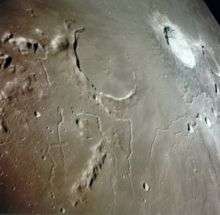Prinz (crater)
|
Lunar Orbiter 5 image | |
| Coordinates | 25°30′N 44°06′W / 25.5°N 44.1°WCoordinates: 25°30′N 44°06′W / 25.5°N 44.1°W |
|---|---|
| Diameter | 46 km |
| Depth | None |
| Colongitude | 44° at sunrise |
| Eponym | Wilhelm Prinz |


Prinz is the lava-flooded remains of a lunar crater on the Oceanus Procellarum. The formation lies to the southwest of the prominent crater Aristarchus. To the north-northeast is the flooded crater Krieger.
The rim of Prinz is the most intact in its northeastern half, while a large gap exists in the southern end of the crater wall. The rim climbs to a maximum height of 1.0 km above the base. It is attached along the eastern rim by a low ridge that is part of the foothills of the small Montes Harbinger range to the northeast. The region of the mare about Prinz is marked by rays and secondary craters from Aristarchus.
Rimae Prinz
Just to the north of Prinz is a system of rilles designated the Rimae Prinz. These are sinuous in nature and extend for up to 80 kilometers. The tiny crater Vera is only a couple of kilometers to the north of Prinz's rim, and serves as the origin of one of these rilles. Within the same rille complex is the tiny crater Ivan. The crater Vera was previously identified as Prinz A, and Ivan as Prinz B, before they were assigned names by the IAU.
| Crater | Longitude | Latitude | Diameter | Name source |
|---|---|---|---|---|
| Ivan | 26.9° N | 43.3° W | 4 km | Russian masculine name |
| Vera | 26.3° N | 43.7° W | 2 km | Latin feminine name |
To the northwest is another distinct rille system designated Rimae Aristarchus.
References
- Andersson, L. E.; Whitaker, E. A. (1982). NASA Catalogue of Lunar Nomenclature. NASA RP-1097.
- Blue, Jennifer (July 25, 2007). "Gazetteer of Planetary Nomenclature". USGS. Retrieved 2007-08-05.
- Bussey, B.; Spudis, P. (2004). The Clementine Atlas of the Moon. New York: Cambridge University Press. ISBN 978-0-521-81528-4.
- Cocks, Elijah E.; Cocks, Josiah C. (1995). Who's Who on the Moon: A Biographical Dictionary of Lunar Nomenclature. Tudor Publishers. ISBN 978-0-936389-27-1.
- McDowell, Jonathan (July 15, 2007). "Lunar Nomenclature". Jonathan's Space Report. Retrieved 2007-10-24.
- Menzel, D. H.; Minnaert, M.; Levin, B.; Dollfus, A.; Bell, B. (1971). "Report on Lunar Nomenclature by the Working Group of Commission 17 of the IAU". Space Science Reviews. 12 (2): 136–186. Bibcode:1971SSRv...12..136M. doi:10.1007/BF00171763.
- Moore, Patrick (2001). On the Moon. Sterling Publishing Co. ISBN 978-0-304-35469-6.
- Price, Fred W. (1988). The Moon Observer's Handbook. Cambridge University Press. ISBN 978-0-521-33500-3.
- Rükl, Antonín (1990). Atlas of the Moon. Kalmbach Books. ISBN 978-0-913135-17-4.
- Webb, Rev. T. W. (1962). Celestial Objects for Common Telescopes (6th revised ed.). Dover. ISBN 978-0-486-20917-3.
- Whitaker, Ewen A. (1999). Mapping and Naming the Moon. Cambridge University Press. ISBN 978-0-521-62248-6.
- Wlasuk, Peter T. (2000). Observing the Moon. Springer. ISBN 978-1-85233-193-1.
